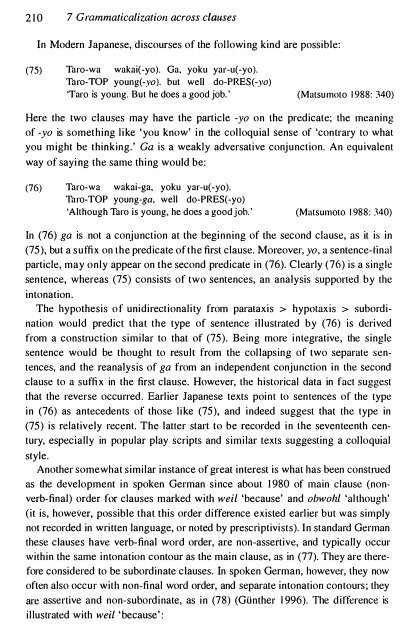Gram - SEAS
Gram - SEAS
Gram - SEAS
You also want an ePaper? Increase the reach of your titles
YUMPU automatically turns print PDFs into web optimized ePapers that Google loves.
210 7 <strong>Gram</strong>maticaLizatiolZ across clauses<br />
In Modern Japanese, discourses of the following kind are possible:<br />
(75) Ta ro-wa wakai(-yo). Ga, yoku yar-u(-yo).<br />
Taro-TOP young(-yo). but well do-PRES(-yo)<br />
'Taro is young. But he does a good job.' (Matsumoto 1988: 340)<br />
Here the two clauses may have the particle -yo on the predicate; the meaning<br />
of -yo is something like 'you know' in the colloquial sense of 'contrary to what<br />
you might be thinking.' Ga is a weakly adversative conjunction. An equivalent<br />
way of saying the same thing would be:<br />
(76) Taro-wa wakai-ga, yoku yar-u(-yo).<br />
Taro-TOP young-ga, well do-PRES(-yo)<br />
'Although Taro is young, he does a good job. ' (Matsumoto 1988: 340)<br />
In (76) ga is not a conjunction at the begi nning of the second clause, as it is in<br />
(75), but a suffix on the predicate of the first clause. Moreover, yo, a sentence-(-inul<br />
particle, may only appear on the second predicate in (76). Clearly (76) is a single<br />
sentence, whereas (75) consists of two sentences, an analysis supported by the<br />
intonation.<br />
The hypothesis of unidirectionality from parataxis > hypotaxis > subordination<br />
would predict that the type of sentence illustrated by (76) is derived<br />
from a construction similar to that of (75). Being more integrative, the single<br />
sentence would be thought to result from the collapsing of two separate sentences,<br />
and the reanalysis of ga from an independent conjunction in the second<br />
clause to a suffix in the first clause. However, the historical data in fact suggest<br />
that the reverse occurred. Earlier Japanese texts point to sentences of the type<br />
in (76) as antecedents of those like (75), and indeed suggest that the type in<br />
(75) is relatively recent. The latter start to be recorded in the seventeenth century,<br />
especially in popular play scripts and similar texts suggesting a colloquial<br />
style.<br />
Another somewhat similar instance of great interest is what has been construed<br />
as the development in spoken German since about 1980 of main clause (nonverb-final)<br />
order for clauses marked with weil 'because' and obwohl 'although'<br />
(it is, however, possible that this order difference existed earlier but was simply<br />
not recorded in written language, or noted by prescriptivists). In standard German<br />
these clauses have verb-final word order, are non-assertive, and typically occur<br />
within the same intonation contour as the main clause, as in (77). They are therefore<br />
considered to be subordinate clauses. In spoken German, however, they now<br />
often also occur with non-final word order, and separate intonation contours; they<br />
are assertive and non-subordinate, as in (78) (Gunther 1996). The difference is<br />
illustrated with weil 'because':
















